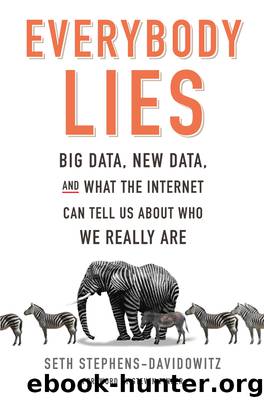Everybody Lies by Seth Stephens-Davidowitz

Author:Seth Stephens-Davidowitz
Language: eng
Format: epub, azw3
ISBN: 9780062390875
Publisher: HarperCollins
Published: 2017-04-07T16:00:00+00:00
My personal favorite study by Raj Chetty’s team, which had access to that massive collection of IRS data, was their inquiry into why some people cheat on their taxes while others do not. Explaining this study is a bit more complicated.
The key is knowing that there is an easy way for self-employed people with one child to maximize the money they receive from the government. If you report that you had taxable income of exactly $9,000 in a given year, the government will write you a check for $1,377—that amount represents the Earned Income Tax Credit, a grant to supplement the earnings of the working poor, minus your payroll taxes. Report any more than that, and your payroll taxes will go up. Report any less than that, and the Earned Income Tax Credit drops. A taxable income of $9,000 is the sweet spot.
And, wouldn’t you know it, $9,000 is the most common taxable income reported by self-employed people with one child.
Did these Americans adjust their work schedules to make sure they earned the perfect income? Nope. When these workers were randomly audited—a very rare occurrence—it was almost always found that they made nowhere near $9,000—they earned either substantially less or substantially more.
In other words, they cheated on their taxes by pretending they made the amount that would give them the fattest check from the government.
So how typical was this type of tax fraud and who among the self-employed with one child was most likely to commit it? It turns out, Chetty and colleagues reported, that there were huge differences across the United States in how common this type of cheating was. In Miami, among people in this category, an astonishing 30 percent reported they made $9,000. In Philadelphia, just 2 percent did.
What predicts who is going to cheat? What is it about places that have the greater number of cheaters and those that have lower numbers? We can correlate rates of cheating with other city-level demographics and it turns out that there are two strong predictors: a high concentration of people in the area qualifying for the Earned Income Tax Credit and a high concentration of tax professionals in the neighborhood.
What do these factors indicate? Chetty and the authors had an explanation. The key motivator for cheating on your taxes in this manner was information.
Most self-employed one-kid taxpayers simply did not know that the magic number for getting a big fat check from the government was $9,000. But living near others who might—either their neighbors or tax assisters—dramatically increased the odds that they would learn about it.
In fact, Chetty’s team found even more evidence that knowledge drove this kind of cheating. When Americans moved from an area where this variety of tax fraud was low to an area where it was high, they learned and adopted the trick. Through time, cheating spread from region to region throughout the United States. Like a virus, cheating on taxes is contagious.
Now stop for a moment and think about how revealing this study is.
Download
This site does not store any files on its server. We only index and link to content provided by other sites. Please contact the content providers to delete copyright contents if any and email us, we'll remove relevant links or contents immediately.
Hit Refresh by Satya Nadella(8345)
The Compound Effect by Darren Hardy(7576)
Change Your Questions, Change Your Life by Marilee Adams(6655)
Nudge - Improving Decisions about Health, Wealth, and Happiness by Thaler Sunstein(6643)
The Black Swan by Nassim Nicholas Taleb(6204)
Daring Greatly by Brene Brown(5652)
Deep Work by Cal Newport(5497)
Principles: Life and Work by Ray Dalio(5334)
Rich Dad Poor Dad by Robert T. Kiyosaki(5162)
The Myth of the Strong Leader by Archie Brown(4795)
Man-made Catastrophes and Risk Information Concealment by Dmitry Chernov & Didier Sornette(4748)
Big Magic: Creative Living Beyond Fear by Elizabeth Gilbert(4734)
The Slight Edge by Jeff Olson(4727)
Discipline Equals Freedom by Jocko Willink(4642)
Digital Minimalism by Cal Newport;(4567)
The Motivation Myth by Jeff Haden(4535)
Stone's Rules by Roger Stone(4422)
Management Strategies for the Cloud Revolution: How Cloud Computing Is Transforming Business and Why You Can't Afford to Be Left Behind by Charles Babcock(4135)
The Doodle Revolution by Sunni Brown(4051)
